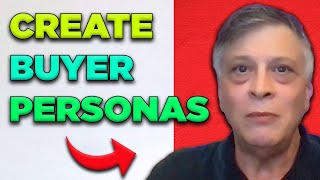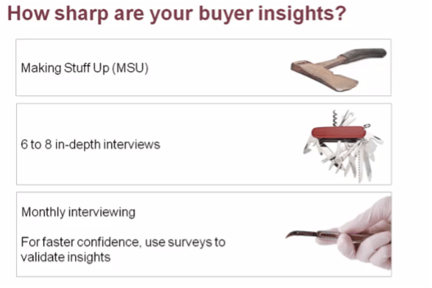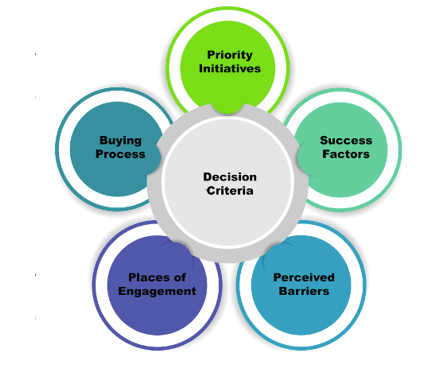How To Create Buyer Personas
EVERY aspect of your marketing and sales program should be tied to a specific buyer persona. Learn the proper way to build them.
BUYER PERSONA REPORTBUYERS' SENTIMENT REPORTBUYERS' JOURNEY REPORTPROCESS
Bill Arnold
11/5/20237 min read


Introduction: This is part two of our Marketing/Sales success series please see part one entitled How to Achieve Marketing Sales Success (The Secrets Revealed).
The internet has a plethora of articles on the importance of knowing your buyer personas, each with its own unique definition or methodology to achieve it. The common thread is the appreciation that understanding your buyer personas is the heart and soul of your marketing program. It will determine if your website, content, and demand generation will resonate with your buyers or fall short.
EVERY aspect of your marketing and sales program should be tied to what a specific buyer persona at a specific stage in the buyer’s journey needs to see. This includes the UX/UI of your website, the subject matter of the content, the type of content, and the distribution of that content. The company that understands and implements this approach usually wins.
While much has been written about buyer personas, and the importance of truly understanding more than just the fundamentals of who they are, a surprising number of companies either have not formally developed them, are guessing who they are, or just substituting demographics for a formal persona. In fact, 60-70% of B2B marketers admit that they don’t truly understand their buyers. (SiriusDecisions, 2016)
What is a Buyer Persona?
A buyer persona is far more than just a person’s demographics, a one-dimensional profile, or even a semi-fictional representation of your ideal customer.
A well-developed buyer persona tells you what factors prospective customers are evaluating, who they are seeking advice from, and where they are going for information and third-party verification as they weigh their options to address a problem that your company resolves.
Fun Fact: In fact, research from the Aberdeen Group reveals that marketers, who align content to specific stages of the buyer's journey, yield 73% higher conversion rates.
Prevail Marketing's Buyer Persona Process
Understanding your buyer personas, their sentiments, and the buyer’s journey is so critical to your success that Prevail Marketing incorporates our buyer persona process into all our engagements. It is no longer sufficient to simply understand your target market, and you certainly don’t want to use demographics, or worse yet, guess. To achieve a relationship with the customer, you must understand what drives them to want to engage your business. We have optimized the user experience, through a three-step process, that is immortalized in three reports:
Buyer Persona Report
Buyers’ Sentiment Report
Buyers’ Journey Report
We are ardent believers in the process that the godmother of buyer personas, Adele Revella, CEO of Buyer Persona Institute, has developed. Like many who have taken her course, become certified, or just read her books, we have added our elements, but the foundation is the same. I encourage those who want to understand the real nuances to either take her masterclass or buy her book.
Buyer Persona Process
There are many benefits derived from knowing who your buyer personas are, what their pain points are, what messaging will compel them, and where and how to reach them. Here are some of the benefits:
Focuses creative and marketing efforts
Determines the messaging and marketing strategy
Allows you to prioritize your marketing investments
Helps the Sales team determine how to engage sales-qualified leads
We believe the only true way to establish buyer personas is to talk to them. One of the most important considerations when doing so is what questions to ask.
Step 1. Interview Stakeholders. We begin the process by interviewing your internal stakeholders, including senior management, marketing, sales, and customer service personnel. The information we want to learn from them is:
Who they believe are their buyer personas
What they think are their pain points and concerns
What information they believe they need to share to each
Where these buyer personas go for information and entertainment
In order to get a clear understanding from a number of perspectives, we typically interview between four to six internal stakeholders. Clients are often amazed at the misalignment of this information between these departments. They also find that they made assumptions that are not supported by what we learned in the next step.
Step 2. Interview Closed-Won Opportunities. We try to specifically target those newly won customers who just completed the buyer’s journey, so their use of the product or service does not influence their answers. This information will serve to establish the buyer insights and sentiments report, and the content that needs to be created to successfully engage them. Our client’s representatives should not attend these interviews. We want the newly won customer to feel no pressure when answering the questions.
Ideally, the interviewer will meet with both the decision maker and the influencer persona for each customer interview. We recommend meeting between three to four customers for a total of six to eight interviews.
Step 3. Interview Closed-Lost Opportunities. Remarkably, the closed-lost interviews garner some of the most important insights and information. For closed-won opportunities, you won the business, so you did enough right to establish a win. But that is not the case with lost opportunities. Something in your process, pricing, or product fell short of the prospect’s expectations. This is where you learn what fell short and have the opportunity to address those issues.
Not surprisingly, these are the most difficult interviews to obtain, because the prospect usually believes this is just another attempt at selling them something they already considered and rejected. The following has proven to be the most effective in getting them to sit for a meeting.
Make it clear that an outside agency that has nothing to do with the sales team is asking for the meeting.
Appeal to their business sense. For example: we always state, “I am sure you wonder why you lost business and where you fell short. We feel the same and would love your input to allow us to improve the process or product. Can we get fifteen minutes of your time?”
Reward them. “We understand that your time is extremely valuable, and you are doing us a favor, so at the conclusion of the meeting, we will send over a gift card for “X” amount.” The valuation of the gift card may vary depending on who you are trying to speak with. A CEO will not sit down for a meeting just because you offer a twenty-five-dollar gift card. Make sure you provide a valuation that will encourage them to attend.
TIP: For a closed-won opportunity, we ask for a thirty-minute meeting, and for the closed-lost opportunity, we only ask for a fifteen-minute meeting. When that time has elapsed, we always ask if they want to continue. Most often, the meeting will continue long past the scheduled period, because they really appreciate someone actually listening to their criticism or recommendations.


Step 4. Repeat – Validate – Update. We know that the development of buyer personas is not a one-and-done activity, so to ensure the information remains relevant, we continue to interview both customers and lost opportunities on a quarterly basis.
For new customers, we recommend that you interview new clients every quarter. These interviews need to be conducted by the marketing team (not sales) and as soon as
possible once they become a client. The reason for the urgency is you don’t want their onboarding or the performance of your product or service to influence their comments.
We recommend, that on an ongoing basis, you should be interviewing two to six new customers and companies that are considered closed-lost. It is extremely important that these interviews be conducted as closely as possible when they become clients or the opportunity is lost.
Conducting the Interviews
The two most important rules are:
1. Listen more than you speak. It is not about how much you know, but how much you can learn
2. Have follow-up questions when they are discussing:
a. Something related to the decision-making process
b. Where and how they educated themselves about potential solutions to their problem
c. What initiated their search for a solution
d. When you don’t understand a term or concept
e. When they are passionate about something
The purpose of these interviews is to drill down and find out the following information:


Priority Initiatives – What made the problem or need become an urgent priority for the buyer (i.e., what triggered the search for a solution?)
Success Factors – What are the buyer’s expectations for success? (From both a business and personal standpoint.)
Perceived Barriers – What barriers prevented this buyer from choosing your company?
Buying Process – What process would make it easy for this buyer to choose your company? (This covers the buyer’s journey from what triggers the search for a solution, the research done, who accessed the solutions, and who had input into the decision. For each person, we need to understand their needs and what resources they consult to learn and evaluate (blogs, social media, influencers, etc.)
Places of Engagement – Where did they go to investigate a solution to the problem? How did they find you? What was compelling on your website, blog, and social media?
Decision Criteria – What criteria did this buyer use to compare options? (Will tell us how the buyer weighed their options.)
While each interview is unique, here are some ideas to begin the inquiry.


TIP – Record and transcribe the interview. You cannot conduct a successful interview if you are trying to manually capture the conversation. Ask permission to record the call at the outset. Make sure you tell them that you don’t want to miss out on a single thing they say, you can’t be listening if you are just trying to write everything down.
This concludes part two of our series entitled How to Achieve Marketing Sales Success (The Secrets Revealed). Please stop back for part three – Buyer Personas The Foundation of Strategic Marketing Best.
Contact:
prevailer@prevail.marketing
(424) 484-9955
